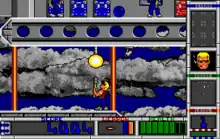Duke Nukem II
Duke Nukem II is a platform game developed by Apogee Software and released December 3, 1993. The game consists of four episodes (of eight levels each), the first available as shareware. It is the follow-up to 1991's Duke Nukem, and followed by Duke Nukem 3D in 1996. Todd Replogle was the primary designer of all three games.
| Duke Nukem II | |
|---|---|
 Cover art | |
| Developer(s) | Apogee Software (MS-DOS) Torus Games (GBC) Interceptor Entertainment (iOS) |
| Publisher(s) | Apogee Software (MS-DOS) GT Interactive Software (GBC) Interceptor Entertainment (iOS) |
| Designer(s) | Todd Replogle George Broussard Scott Miller Allen H. Blum III |
| Artist(s) | Randy Abraham Stephen A. Hornback |
| Writer(s) | Tom Hall |
| Composer(s) | Robert Prince |
| Series | Duke Nukem |
| Engine | Updated Duke Nukem engine[1] |
| Platform(s) | DOS, Game Boy Color, iOS, Microsoft Windows, OS X |
| Release | DOS Game Boy Color iOS
|
| Genre(s) | Platform |
| Mode(s) | Single-player |
Plot
In 1998, the evil Rigelatins plan to enslave Earth, and they kidnap Duke Nukem, to use his brain to plot the attack for their forces. Duke breaks free to save the world again.
Gameplay

The player's goal is to proceed through the levels collecting items, destroying enemies to the level exit and at the final level, defeat the super alien boss. In one level of each episode Duke needs to destroy radar dishes to progress.
Duke Nukem can pick up weapons along the way. There are four types of weapons: His regular default gun, the flamethrower (which can shoot through walls and launch him in the air), the laser (which can shoot through anything) and the rocket launcher. Duke can also get a rapid fire powerup. Health items can be collected to heal damage Duke receives or to boost score points at full health. Keycards need to be collected to access past the force fields and keys must be obtained to get past locked doors. A cloaking device makes Duke temporarily invincible and disables the super force fields.
Movement through the levels mainly consists of jumping onto platforms, climbing ladders, operating elevators, using teleporters, hovering over blowing fans and climbing hand-over-hand across pipes or girders. At the end of every level (with the exception of the last level in each episode), the player can receive up to seven 100,000 point bonuses, earned by making certain achievements in the level, such as destroying all cameras.
Development
The game uses VGA and EGA graphics and draws two backgrounds ("dual-parallax scrolling"). The game took almost two years to create.[1]
Game Boy Color version
The Game Boy Color version of Duke Nukem II was titled Duke Nukem. It was released on September 10, 1999 in North America. Several of the backgrounds closely resemble those of the earlier DOS version of the game. However, the Rigelatins have been replaced with the Zorgonites, the arsenal of weapons and items have been modified and the levels, graphics, music, vehicles, enemies and bosses are brand new. Furthermore, Duke has the ability to hang onto the edge of platforms in the Game Boy Color game. The game features 21 levels of play and eight save game slots.
Reception
Allgame gave Duke Nukem II 3 out of 5 stars for the original DOS version, and 4 out of 5 for the GameBoy Color version.
PC Zone gave the game 4 out of 5 stars.
References
- Scott Miller - Bio-Menace Readme text file
- "3D Realms Site: History". 3D Realms.
- http://web.archive.org/web/20011101183028/http://www.3drealms.com/press/gbship.html
- McElroy, Griffin (3 April 2013). "Duke Nukem 2 launches on iOS today". Polygon. Vox Media. Retrieved 6 December 2013.
- "Release: Duke Nukem 1+2". GOG.com. 6 December 2012. Retrieved 6 May 2019.
- "Duke Nukem 1 and 2 now available for Mac on GOG.com". Engadget. 6 December 2012. Retrieved 6 May 2019.
- "Changelog post #1". GOG.com. Retrieved 6 May 2019.
- Burgess, Mark (March 1994). "PC Zone Review - Duke Nukem II". PC Zone. No. 12. Future plc. p. 130.
